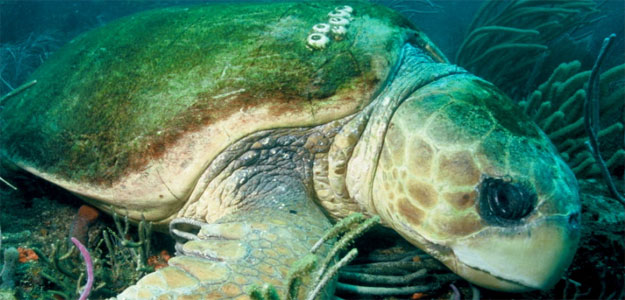
The Zakynthos Saga
 Thanks to their unique behavior that brings them back to the beaches on which they were born, sea turtles are often
an easy target for habitat disruption. Some of the beaches of Greece play host to an important population of loggerhead sea turtles, and several Greek
conservationists have long advocated for their protection, and continue to serve as watchdogs today. (Photo Courtesy of ?2005 D.Schrichte)
Thanks to their unique behavior that brings them back to the beaches on which they were born, sea turtles are often
an easy target for habitat disruption. Some of the beaches of Greece play host to an important population of loggerhead sea turtles, and several Greek
conservationists have long advocated for their protection, and continue to serve as watchdogs today. (Photo Courtesy of ?2005 D.Schrichte)
By Lily Venizelos
Greece hosts approximately 60 percent of all loggerhead sea turtle nests in the Mediterranean. Forty-two percent of these are laid across a 5.5-kilometer stretch of six beaches along Laganas Bay on the island of Zakynthos, in Greece. One of these, Sekania, bears the largest known concentration of loggerhead nests in the world! Sea turtles' particular physiology of nesting only on beaches where they were hatched makes their protection a priority. Unplanned development to increase tourism in the 1980s has created major problems to the nesting beaches of Zakynthos.
In 1983, I started lobbying the Greek authorities for protective legislation of the Laganas nesting beaches. Coastal development continued to increase, largely due to local resistance, mass-tourism development and non-implementation of local, national, international and European Commission (EC) legislation.
In 1985, I commenced drawing the attention of the Standing Committee to the Convention on the Conservation of European Wildlife and Natural Habitats (also known as the Bern Convention) of the plight of the sea turtles on their significant nesting beaches in Zakynthos. The initiative was taken over and carried on after 1988 by the newly formed NGO, MEDASSET, with yearly reports and Recommendations, exerting pressure for change.
In 1994, MEDASSET launched a formal complaint to the European Commission for the failure of the Greek government to apply national and international law concerning the preservation of sea turtles in Zakynthos. Having our complaints turned down three times, we appealed to the European Ombudsman. This eventually led to an "on the spot" appraisal of Laganas Bay by the European Commission in 1998 and the commencement of infringement procedures against Greece in 1999, which took the Greek Government to the European Court of Justice (ECJ).
The long awaited Presidential Decree providing the constitution for the Zakynthos National Marine Park (ZNMP) was signed immediately after the Commission's announcement in order to avoid severe fines.
Nevertheless, between December 2004 and June 2005, the ZNMP remained non-functioning due to lack of government funding. Under the threat of potential penalties by the European Commission and to avoid the ECJ ruling, the Ministry of Environment then provided some funds and appointed a new President of the Park.
Unfortunately, following the 2006 nesting season, the European Commission declared that the Park was "progressively managed" and closed the case at the ECJ. This decision was made despite the fact that the park management, with the support of the Ministry, had allowed further illegal development of the 'Strictly Protected' nesting beach of Daphne, in order to gain the local community's support towards the park. The once pristine nesting beach, now a 'small village', has had annual compromises to its ecological integrity.
To this day, prohibited fishing activities and boats illegally entering the maritime zones kill several turtles in the bay each year, while tourists are still found walking the beaches during the night. Available sand dunes for nesting have significantly reduced over the years. A major waste disposal site, operating just above Sekania Beach, has yet to be sealed and moved away, so seagulls continue to prey on hatchlings. Two new car parks and road developments contribute to the poorly regulated visitor numbers on some of the nesting beaches. How such dramatic developments prevail in such an important "restricted" nesting ground is a question that many avoid answering. However, the European Commission's position remains that the Park is "progressively managed".
Sea turtle conservation in Zakynthos is a clear example of insufficient conservation legislation enforcement, mismanagement, uncontrolled tourism development and non-compensation of the local community affected by the conservation legislation.
After a 25-year struggle, the situation is slowly improving, although there are several issues that prevail. There is clearly an overall need for transparency, stakeholder engagement, communication and empowerment. The roles and responsibilities of the ZNMP and the conflicting interests between sub-groups in the community are all issues that have to be addressed in order for any substantial change to occur. The importance of identifying barriers to change so that progress can be achieved can not be stressed enough.
MEDASSET continues campaigning, monitoring and reporting on the situation of the nesting beaches in Zakynthos, hoping one day for major positive change.
Lily Venizelos is the president of MEDASSET and a United Nations Environmental Program Global 500 Laureate.


